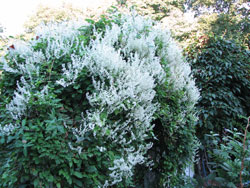Resource Library
Plant of the Week: Vine, Silver Lace
The University of Arkansas System Division of Agriculture does not promote, support or recommend plants featured in "Plant of the Week." Please consult your local Extension office for plants suitable for your region.
Plant of the Week
[A-Z]
Silver Lace Vine
Latin: Fallopia baldschuanica

Choosing a vine for the garden is a tricky business. The perfect vine would be one that is beautiful, easy to grow and stops at the end of the trellis. The stopping part - or perhaps more accurately failing to stop - is a critical feature to consider when introducing any vine into the garden. Silver lace vine (Fallopia baldschuanica)is a beautiful vine but it does have a wild heart.
Silver lace vine is a member of the smartweed family, and as such is often included in that group under the synonym name Polygonum aubertii. It is a fast-growing, semi-woody perennial that climbs by twining or will scamper across the ground or low growing shrubbery. It starts re-growth early and climbs to a height of 12 to 15 feet in the season. Old vines can attain 25 feet or more in height. Its heart shaped leaves are up to two inches long; they die with the first hard freeze without displaying any fall color.
In late summer and early fall masses of white, fragrant flowers are produced in terminal clusters. Individual flowers are about one-fifth of an inch across, five-petaled and, on female flowers, produce fluted wings on the small, triangular ovary. These wings are often tinged with green or, as the fruit ripens, red. Vines bloom over a two-month period and drop spent blossoms during this period, so it might not be a good choice over patios and other hard surfaces.
The silver lace vine has an identity crisis. As a war-time refugee - in this instance it was collected in Central Asia during the late 19th century when Great Britain and Russia were locked in a conflict called “the Great Game” - its place in proper society has been in question. Today American forces are fighting in the same region.
Albert von Regel, serving as a doctor for the Russian Army, collected seeds of the vine in 1882 in Turkestan and sent it to his father, who was the director of the botanic garden in St. Petersburg. In 1896 the plant was first listed in the catalog of France’s most famous nurseryman, Victor Lemoine. About that same time a missionary named Georges Aubert sent seeds he collected in Tibet back to France, where it was named Polygonum aubertii in his honor. Later the two species were determined to be the same and the great name confusion began.
While silver lace vine is the most commonly encountered name for the species, it also goes by names such as mile-a-minute vine, Russian vine and China fleece flower. Botanists, depending on their views on lumping or splitting, separate the dozen or so climbing Asian species out into the genus Fallopia or retain the traditional name Polygonum.
Silver lace vine is an easily grown deciduous vine well-suited for covering fences, arbors or other garden structures. Though an aggressive spreader, it shouldn’t be confused with wisteria. It does best in full sun locations and is most vigorous in fertile, well-cared for sites. One easy way of controlling its rampant spread is to plant it in more difficult locations and allow it to fend for itself.
Any vine with the potential for escaping its trellis should be planted where its spread to adjacent areas can be controlled. Severe pruning at any season can be used to control spread. It is hardy from zones 4 through 8. Japanese beetles are the most serious pest of this plant.
By: Gerald Klingaman, retired
Extension Horticulturist - Ornamentals
Extension News - October 9, 2009
The University of Arkansas System Division of Agriculture does not maintain lists of retail outlets where these plants can be purchased. Please check your local nursery or other retail outlets to ask about the availability of these plants for your growing area.